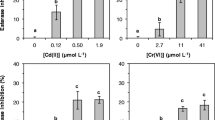Abstract
Sensitive detection of heavy metal (HM) stress in aquatic plants by dissolved oxygen (DO)-quenched fluorescence/materials movement-induced beam deflection method is demonstrated. Egeria densa Planchon and Cu2+ were used as a model aquatic plant and HM ion, respectively. Reproducibility and experimental errors of the method were first investigated in a control culture solution only containing 10−6 M Ru (II) complex (Tris (2,2’-bipyridyl) ruthenium (II) chloride) without addition of any fertilizer and Cu2+. Changes of DO concentration (∆DO) and deflection (∆DE) during the monitoring periods were used as parameters to quantitatively evaluate the experimental errors and detection limits. Averages or means (\(\overline{\Delta DO }\), \(\overline{\Delta DE }\)) and standard deviations (σ∆DO, σ∆DE) of ∆DO and ∆DE in seven control experiments with different aquatic plants sheets during both the respiration and photosynthesis processes were obtained. Next, DO and deflection at the middle vicinities of the aquatic plant were monitored during 2 h of both respiration and photosynthesis in presence of 10–10 ~ 10–6 M Cu2+. Experimental results showed that the aquatic plant began to suffer from the HM stress in some extent in presence of 10–9 M Cu2+. When the concentration of Cu2+ was higher than 10–8 M, changing trends of both DO and deflection with time were not reversed during the respiration and photosynthesis, implying that the materials movements in the physiological activities had been altered greatly. It is demonstrated that the method could sensitively detect the HM stress in the aquatic plants given by nM HM ions in culture solution without addition of a fertilizer. Furthermore, detection limits of the method were quantitatively discussed by considering \(\overline{\Delta DO }-3\) σ∆DO and \(\overline{\Delta DE }+3\) σ∆DE as the minimum detectable changes of DO and deflection caused by the HM stress, respectively.
Graphical Abstract






Similar content being viewed by others
Data availability
The authors declare that the data supporting the findings of this study are available within the paper. Should any raw data files be needed in another format they are available from the corresponding author upon reasonable request.
References
R. Riyazuddin, N. Nisha, K. Singh, R. Verma, R. Gupta, Plant Cell Rep. 41, 519 (2022). https://doi.org/10.1007/s00299-021-02720-6
B. Printz, S. Lutts, J.-F. Hausman, K. Sergeant, Front. Plant Sci. 7, 1 (2016). https://doi.org/10.3389/fpls.2016.00601
N.H. Ghori, T. Ghori, M.Q. Hayat, S.R. Imadi, A. Gul, V. Altay, M. Ozturk, Int. J. Environ. Sci. Technol. 16, 1807 (1807). https://doi.org/10.1007/s13762-019-02215-8
Z. Zhang, M. Liu, X. Liu, G. Zhou, Sensors 18, 2172 (2012). https://doi.org/10.3390/s18072172
D.K. Gupta, F.J. Corpas, J.M. Palma, Heavy metal stress in plants (Springer-Verlag, Berlin, 2013)
N.G. Guanzon, H. Nakahara, Y. Yoshida, Fish Sci. 60, 379 (1994). https://doi.org/10.2331/fishsci.60.379
S. Hunt, Physiol. Plant 117, 314 (2003). https://doi.org/10.1034/j.1399-3054.2003.00055.x
K. Rohacek, M. Bartak, Photosynthetica 37, 339 (1999)
H. Huang, F. Ullah, D.-X. Zhou, M. Yi, Y. Zhao, Front. Plant Sci. 10, 1 (2019). https://doi.org/10.3389/fpls.2019.00035
F.A. Bazzaz, R.W. Carlson, G.L. Rolfe, Environ. Pollut. 7, 241 (1974). https://doi.org/10.1016/0013-9327(74)90032-9
H. Clijsters, F.V. Assche, Photosyn. Res. 1985(7), 31 (1985). https://doi.org/10.1007/BF00032920
M.E. Soltan, M.N. Rashed, Adv. Environ. Res. 7, 321 (2003). https://doi.org/10.1016/S1093-0191(02)00002-3
A. Giannakoula, I. Therios, C. Chatzissavvidis, Plants 10, 155 (2021). https://doi.org/10.3390/plants10010155
X.-Z. Wu, P. Sansuku, Environ. Monit. Contam. Res. 1, 91 (2021). https://doi.org/10.5985/emcr.20210006
X.-Z. Wu, X. Wu, T. Inoue, Anal. Sci. 33, 351 (2017). https://doi.org/10.2116/analsci.33.351
M. Yarrow, V.H. Marin, M. Finlayson, A. Tironi, Rev. Chil. Hist. Nat. 82(2), 299 (2009). https://doi.org/10.4067/S0716-078X2009000200010
I. Yruela, Funct. Plant Biol. 36, 409 (2009). https://doi.org/10.1590/S1677-04202005000100012
W. Xing, W. Huang, G. Liu, Environ. Toxicol. 25, 103 (2010). https://doi.org/10.1002/tox.20480
X.-Z. Wu, L. Huang, Anal. Sci. 34, 1335 (2018). https://doi.org/10.2116/analsci.18N010
H.M. Kalaji, G. Schansker, R.J. Ladle, M. Zivcak et al., Photosynth. Res. 122, 121 (2014). https://doi.org/10.1007/s11120-014-0024-6
K. Maxwell, G.N. Johnson, J. Exp. Bot. 51, 659 (2000). https://doi.org/10.1093/jxb/51.345.659
R. Mehrandish, A. Rahimian, A. Shahriary, J. Herbmed. Pharmacol. 8(2), 69 (2019). https://doi.org/10.15171/jhp.2019.12
D.A. Skoog, F.J. Holler, T.A. Nieman, Principles of instrumental analysis, 5th edn. (Saunders College Publishing, Toronto, 1998)
X.-Z. Wu, M. Yamada, T. Hobo, S. Suzuki, Anal. Chem. 61, 1505 (1989). https://doi.org/10.1021/ac00189a009
S. Kawakubo, H. Ogusu, M. Iwatsuki, Bunseki Kagaku 60, 579 (2011). https://doi.org/10.2116/bunsekikagaku.60.579
F. Monnet, F. Bordas, V. Deluchat, M. Baudu, Chemosphere 65, 1806 (1806). https://doi.org/10.1016/j.chemosphere.2006.04.022
S. Puig, N. Andres-Colas, A. Garcia-Molina, L. Peñarrubia, Plant Cell Environ. 30, 271 (2007). https://doi.org/10.1111/j.1365-3040.2007.01642.x
M. Gao, X. Chang, Y. Yang, Z. Song, Plant Physiol. Biochem. 154, 287 (2020). https://doi.org/10.1016/j.plaphy.2020.06.021
E. Yotsova, A. Dobrikova, M. Stefanov, S. Misheva, M. Bardáˇcová, I. Matušíková, L. Žideková, A. Blehová, E. Apostolova, Plant Physiol. Biochem. 155, 789 (2020). https://doi.org/10.1016/j.plaphy.2020.06.042
H. Dai, Y. Xu, L. Zhao, C. Shan, Braz. J. Bot 39, 787 (2016). https://doi.org/10.1007/s40415-016-0250-6
Acknowledgements
This work was partly supported by Grant-in Aid for Scientific Research (Nos. 24550109 and 20K05572) from the Japan Society for the Promotion of Science (JSPS).
Author information
Authors and Affiliations
Corresponding author
Rights and permissions
Springer Nature or its licensor (e.g. a society or other partner) holds exclusive rights to this article under a publishing agreement with the author(s) or other rightsholder(s); author self-archiving of the accepted manuscript version of this article is solely governed by the terms of such publishing agreement and applicable law.
About this article
Cite this article
Wu, XZ., Patthamawan, K. & Okuhata, Y. Sensitive detection of heavy metal stress in aquatic plants by dissolved oxygen-quenched fluorescence/materials movement-induced beam deflection method. ANAL. SCI. 39, 1993–2000 (2023). https://doi.org/10.1007/s44211-023-00412-7
Received:
Accepted:
Published:
Issue Date:
DOI: https://doi.org/10.1007/s44211-023-00412-7



